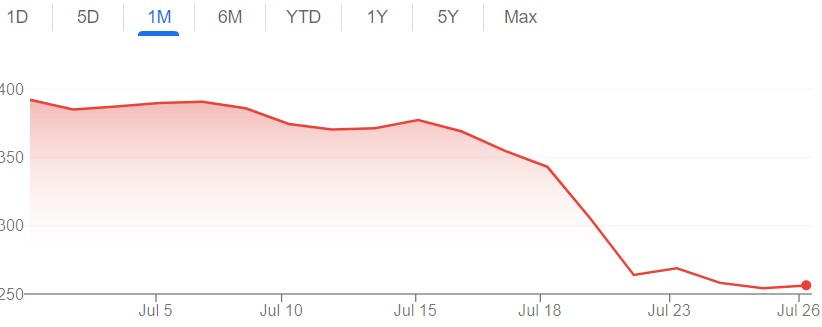Contrarian investing: can you make money in a crisis?

How brave investors can make bumper returns when share prices fall.
Are you willing to invest in companies during their darkest days in the hope of bagging yourself a bumper profit when their share prices recover?
If so, then a contrarian investing style could be for you.
This concept sees investors buying shares of businesses that have gone through a crisis.
Here, we take a look at the pros and cons of this approach, some recent stock examples that fit the bill, and the investment funds that embrace this area.
What is contrarian investing?
A contrarian is someone who takes a different approach to everyone else. In financial terms, this means they’ll be investing money when others are making withdrawals.
This type of investor will search for what they believe to be undervalued companies or those whose share prices have been hit for a variety of reasons.
It could be down to problems encountered by the business, a disappointing set of financial results, or even wider issues that are affecting the sector in which it operates.
They will then buy into the shares at the – hopefully temporary – lower price and hold the stock until this starts to rise.
According to Darius McDermott, managing director of FundCalibre, when it works there can be considerable upside on the share prices of companies that have been oversold
“By nature of going against the herd, contrarian investors tend to have to take a much longer-term horizon to wait out their prediction,” he said.
CrowdStrike bears the brunt
A recent example of a company under pressure is CrowdStrike. This US cybersecurity firm has seen its valuation crumbling after a faulty update triggered a global technology outage in July.
It meant the company’s stock price slumped 26% from $342.89 to $254.15 as nervous investors started selling shares as soon as the story broke.
Malik Ahmed Khan, an equity analyst at Morningstar, branded the market’s reaction as “overly punitive”, especially given there wasn’t a breach of CrowdStrike’s security apparatus.
He has a fair value estimate of $300 on the shares.
“We think the current pullback represents a good buying opportunity for long-term investors looking for high-quality security/software exposure,” he said.

Contrarian opportunities
The CrowdStrike situation represents an opening for contrarian investors who want to make the most of share price weakness to start buying.
The hope is that buying into a stock when its price has sunk to low levels can lead to a bumper profit when the dark clouds pass and it starts to rise again.
Markets can overreact to news and that can lead to price drops that don’t reflect the underlying fundamentals, according to Myron Jobson, senior personal finance analyst at interactive investor.
“Contrarian investing is about exploiting these overreactions which could pay off in a big way,” he explained.
However, there are no guarantees. When companies experience problems, their valuations may end up falling further. In worst-case scenarios, the stock prices may never recover.
“Going against the grain inherently involves higher risk,” added Jobson. “The market consensus can be wrong, but so can the contrarian view. Attempting to time the market can lead to painful losses.”
Patience is required
A contrarian investment style also requires patience.
According to Myron Jobson, it can take a long time for the market to recognise the value in out-of-favour assets, leading to potential underperformance in the short term.
“There is also a real risk of your investment remaining in the doldrums by the time you need to disinvest,” he said.
In addition, not all undervalued stocks are bargains.
“Some may be undervalued for a good reason, such as poor management or declining industries,” he added. “Identifying true value requires deep analysis and a strong understanding of market fundamentals.”
Stocks v funds
Investing in individual stocks is a potentially risky approach for all of the reasons that we have covered. So, what is the alternative?
Well, one option is putting your money into an investment fund that’s run by a professional manager who takes a contrarian approach.
Contrarian fund managers use their skills and resources to scrutinise stocks, sectors and countries, to see if the stock market is wrong or overlooked parts of the story.
This means they will own several such stocks fitting the undervalued criteria that are held in a portfolio that’s been put together by the pooled resources of many investors.
Fund suggestions
Unfortunately, there’s not a specific sector catering to contrarian funds because it’s all down to the approach of individual managers at the helm.
Therefore, funds with such styles can be found in a wide variety of investment sectors and different parts of the world.
FundCalibre’s McDermott highlighted two funds that could be worth considering by investors wanting exposure to a contrarian approach: TM Redwheel Global Equity and M&G Episode Income.
TM Redwheel Global Equity is an income fund run by a team led by manager Nick Clay. It’s seen as a true contrarian portfolio that’s broadly diversified across sectors.
M&G Episode Income, meanwhile, is a multi-asset fund that invests in individual stocks and bonds, as well as property funds.
The manager uses an investment philosophy known as behavioural finance to find pockets of value and is known for investing against the herd, as opposed to following it.
The information included in this article does not constitute regulated financial advice. You should seek independent, professional financial advice before making any investment decision.
Most Recent
Comments
Be the first to comment
Do you want to comment on this article? You need to be signed in for this feature








